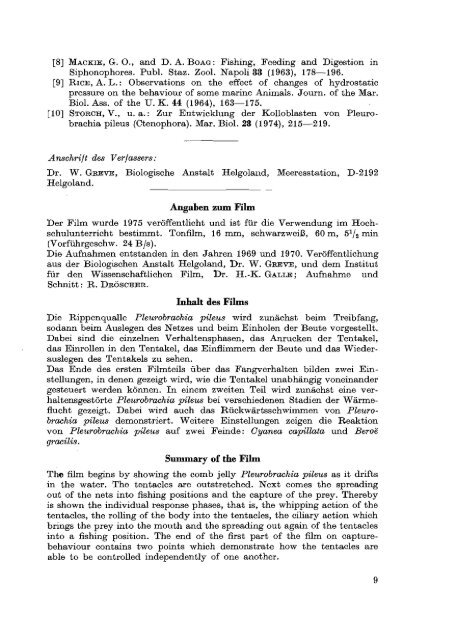Verhaltensweisen der Rippenqualle Pleurobrachia pileus ...
Verhaltensweisen der Rippenqualle Pleurobrachia pileus ...
Verhaltensweisen der Rippenqualle Pleurobrachia pileus ...
Erfolgreiche ePaper selbst erstellen
Machen Sie aus Ihren PDF Publikationen ein blätterbares Flipbook mit unserer einzigartigen Google optimierten e-Paper Software.
[8] MACIEIE, G. O., and D. A. BOAG: Fishing, Feeding and Digestion in<br />
Siphonophores. Publ. Staz. Zool. Napoli 33 (1963), 178-196.<br />
[9] RICE, A. L.: Observations on the effect of changes of hydrostatic<br />
pressure on the behaviour of some marine Animals. Journ. of the Mar.<br />
Biol. Ass. of the U. K. 44 (1964), 163-175.<br />
[10] STORCH, V., U. a.: Zur E~itwicklung <strong>der</strong> Kolloblasten von <strong>Pleurobrachia</strong><br />
<strong>pileus</strong> (Ctenophora). Mar. Biol. 28 (1974), 215-219.<br />
Anschrift des Verfassers:<br />
Dr. W. GREVE, Biologische Anstalt Helgolaild, Meeresstation, D-2192<br />
Helgoland.<br />
Angaben zum Film<br />
Der Film wurde 1975 veröffentlicht und ist für die Verwendung im Hochschulunterricht<br />
bestimmt. Tonfilm, 16 mm, schwarzweiß, 60 m, 5*/, min<br />
(Vorführgeschw. 24 BIS).<br />
Die Aufnahmen entstanden in den Jahren 1969 und 1970. Veröffentlichung<br />
aus <strong>der</strong> Biologischen Anstalt Helgoland, Dr. W. GREVE, und dem Institut<br />
für den Wissenschaftlichen Film, Dr. H.-K. GALLE ; Aufnahme und<br />
Schnitt : R. DR~SCHER.<br />
Inhalt des Films<br />
Die <strong>Rippenqualle</strong> <strong>Pleurobrachia</strong> <strong>pileus</strong> wird zunächst beim Treibfang,<br />
sodann beim Auslegen des Netzes und beim Einholen <strong>der</strong> Beute vorgestellt.<br />
Dabei sind die einzelnen Verhaltensphasen, das Anrucken <strong>der</strong> Tentakel,<br />
das Einrollen in den Tentakel, das Einflimmern <strong>der</strong> Beute und das Wie<strong>der</strong>auslegen<br />
des Tentakels zu sehen.<br />
Das Ende des ersten Filmteils über das Fangverhalten bilden zwei Einstellungen,<br />
in denen gezeigt wird, wie die Tentakel unabhängig voneinan<strong>der</strong><br />
gesteuert werden können. In einem zweiten Teil wird zunächst eine verhaltensgestörte<br />
<strong>Pleurobrachia</strong> <strong>pileus</strong> bei verschiedenen Stadien <strong>der</strong> Wärmeflucht<br />
gezeigt. Dabei wird auch das Rückwärtsschwimmen von <strong>Pleurobrachia</strong><br />
<strong>pileus</strong> demonstriert. Weitere Einstellungen zeigen die Reaktion<br />
von <strong>Pleurobrachia</strong> <strong>pileus</strong> auf zwei Feinde: Cyanea capillata und Beroe<br />
gracilis.<br />
Summary of the Film<br />
The film begins by showing the comb jelly <strong>Pleurobrachia</strong> <strong>pileus</strong> as it drifts<br />
in the water. The tentacles are outstretched. Next Comes the spreading<br />
out of the nets into fishing positions and the capture of the prey. Thereby<br />
is shown the individual response phases, that is, the whipping action of the<br />
tentacles, the rolling of the body into the tentacles, the ciliary action which<br />
brings the prey into the mouth and the spreading out again of the tentacles<br />
into a fishing position. The end of the first part of the film on capturebehaviour<br />
contains two points which demonstrate how the tentacles are<br />
able to be controlled independently of one another.

















